C. Tellambura
Transmit Power Optimization for Integrated Sensing and Backscatter Communication
Apr 29, 2024Abstract:Ambient Internet of Things networks use low-cost, low-power backscatter tags in various industry applications. By exploiting those tags, we introduce the integrated sensing and backscatter communication (ISABC) system, featuring multiple backscatter tags, a user (reader), and a full-duplex base station (BS) that integrates sensing and (backscatter) communications. The BS undertakes dual roles of detecting backscatter tags and communicating with the user, leveraging the same temporal and frequency resources. The tag-reflected BS signals offer data to the user and enable the BS to sense the environment simultaneously. We derive both user and tag communication rates and the sensing rate of the BS. We jointly optimize the transmit/received beamformers and tag reflection coefficients to minimize the total BS power. To solve this problem, we employ the alternating optimization technique. We offer a closed-form solution for the received beamformers while utilizing semi-definite relaxation and slack-optimization for transmit beamformers and power reflection coefficients, respectively. For example, with ten transmit/reception antennas at the BS, ISABC delivers a 75% sum communication and sensing rates gain over a traditional backscatter while requiring a 3.4% increase in transmit power. Furthermore, ISABC with active tags only requires a 0.24% increase in transmit power over conventional integrated sensing and communication.
Enhancing AmBC Systems with Deep Learning for Joint Channel Estimation and Signal Detection
Nov 15, 2023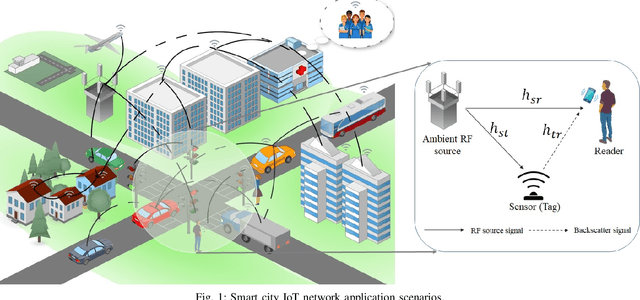
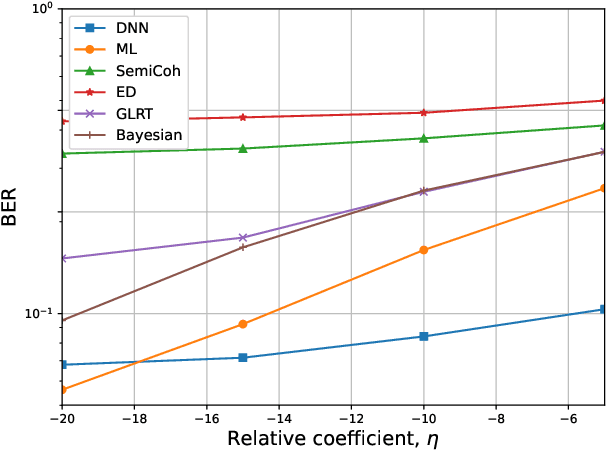

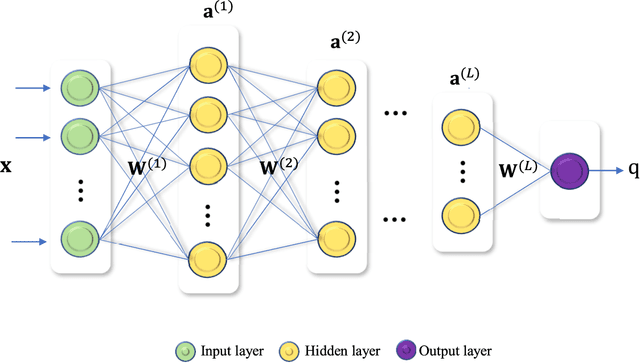
Abstract:The era of ubiquitous, affordable wireless connectivity has opened doors to countless practical applications. In this context, ambient backscatter communication (AmBC) stands out, utilizing passive tags to establish connections with readers by harnessing reflected ambient radio frequency (RF) signals. However, conventional data detectors face limitations due to their inadequate knowledge of channel and RF-source parameters. To address this challenge, we propose an innovative approach using a deep neural network (DNN) for channel state estimation (CSI) and signal detection within AmBC systems. Unlike traditional methods that separate CSI estimation and data detection, our approach leverages a DNN to implicitly estimate CSI and simultaneously detect data. The DNN model, trained offline using simulated data derived from channel statistics, excels in online data recovery, ensuring robust performance in practical scenarios. Comprehensive evaluations validate the superiority of our proposed DNN method over traditional detectors, particularly in terms of bit error rate (BER). In high signal-to-noise ratio (SNR) conditions, our method exhibits an impressive approximately 20% improvement in BER performance compared to the maximum likelihood (ML) approach. These results underscore the effectiveness of our developed approach for AmBC channel estimation and signal detection. In summary, our method outperforms traditional detectors, bolstering the reliability and efficiency of AmBC systems, even in challenging channel conditions.
Improved Signal Detection for Ambient Backscatter Communications
Jun 22, 2023Abstract:In ambient backscatter communication (AmBC) systems, passive tags connect to a reader by reflecting an ambient radio frequency (RF) signal. However, the reader may not know the channel states and RF source parameters and can experience interference. The traditional energy detector (TED) appears to be an ideal solution. However, it performs poorly under these conditions. To address this, we propose two new detectors: (1) A joint correlation-energy detector (JCED) based on the first-order correlation of the received samples and (2) An improved energy detector (IED) based on the p-th norm of the received signal vector. We compare the performance of the IED and TED under generalized noise modeled using the McLeish distribution and derive a general analytical formula for the area under the receiver operating characteristic (ROC) curves. Based on our results, both detectors outperform TED. For example, the probability of detection with a false alarm rate of 1% for JCED and IED is 14% and 5% higher, respectively, compared to TED. These gains are even higher using the direct interference cancellation (DIC) technique, with increases of 16% and 7%, respectively. Overall, our proposed detectors offer better performance than the TED, making them useful tools for improving AmBC system performance.
User Scheduling and Trajectory Optimization for Energy-Efficient IRS-UAV Networks with SWIPT
Sep 12, 2022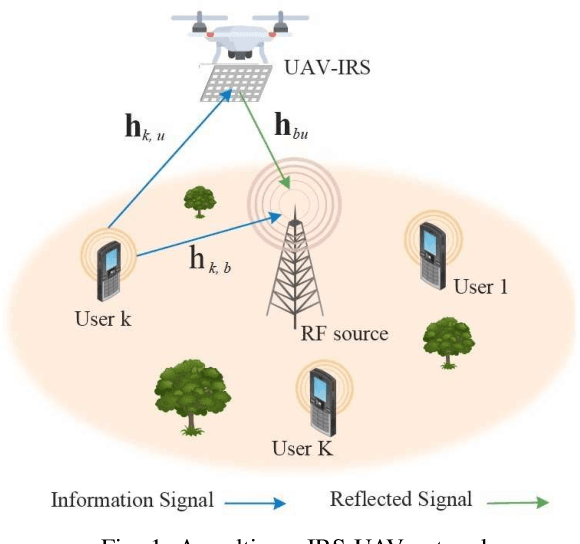
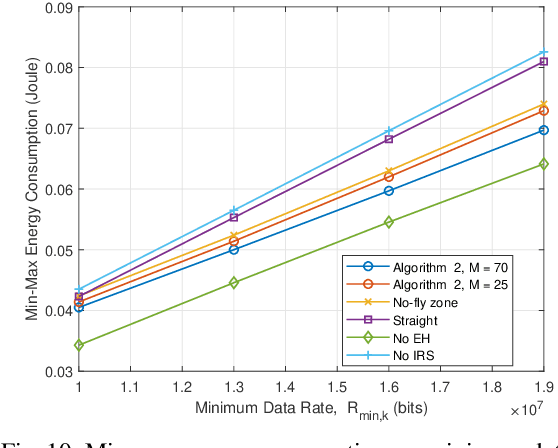
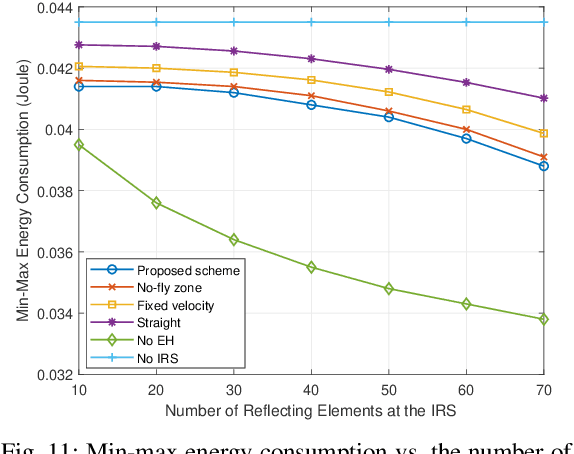
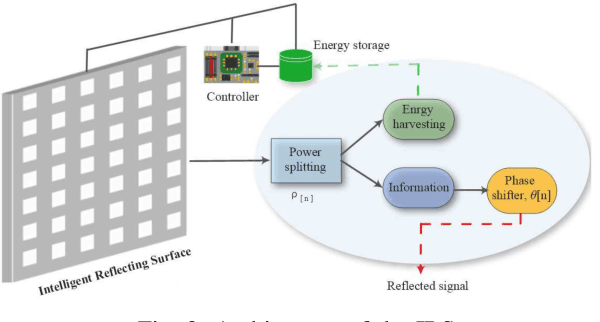
Abstract:This paper investigates user scheduling and trajectory optimization for a network supported by an intelligent reflecting surface (IRS) mounted on an unmanned aerial vehicle (UAV). The IRS is powered via the simultaneous wireless information and power transfer (SWIPT) technique. The IRS boosts users' uplink signals to improve the network's longevity and energy efficiency. It simultaneously harvests energy with a non-linear energy harvesting circuit and reflects the incident signals by controlling its reflection coefficients and phase shifts. The trajectory of the UAV impacts the efficiency of these operations. We minimize the maximum energy consumption of all users by joint optimization of user scheduling, UAV trajectory/velocity, and IRS phase shifts/reflection coefficients while guaranteeing each user's minimum required data rate and harvested energy of the IRS. We first derive a closed-form solution for the IRS phase shifts and then address the non-convexity of the critical problem. Finally, we propose an alternating optimization (AO) algorithm to optimize the remaining variables iteratively. We demonstrate the gains over several benchmarks. For instance, with a 50-element IRS, min-max energy consumption can be as low as 0.0404 (Joule), a 7.13% improvement over the No IRS case (achieving 0.0435 (Joule)). We also show that IRS-UAV without EH performs best at the cost of circuit power consumption of the IRS (a 20% improvement over the No IRS case).
Energy-Efficient Hybrid Offloading for Backscatter-Assisted Wirelessly Powered MEC with Reconfigurable Intelligent Surfaces
Jun 01, 2022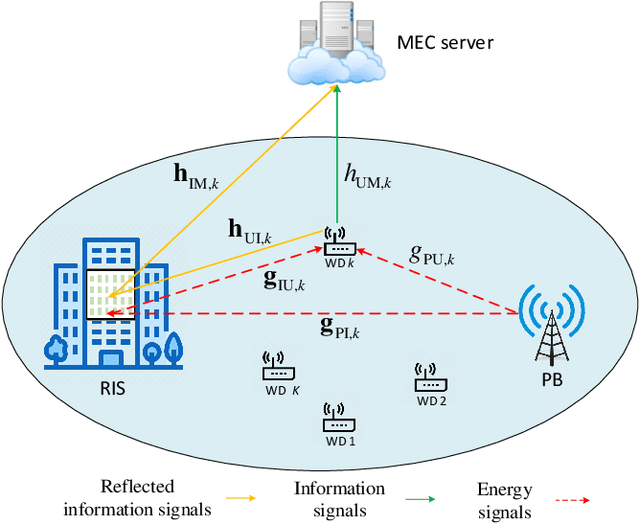
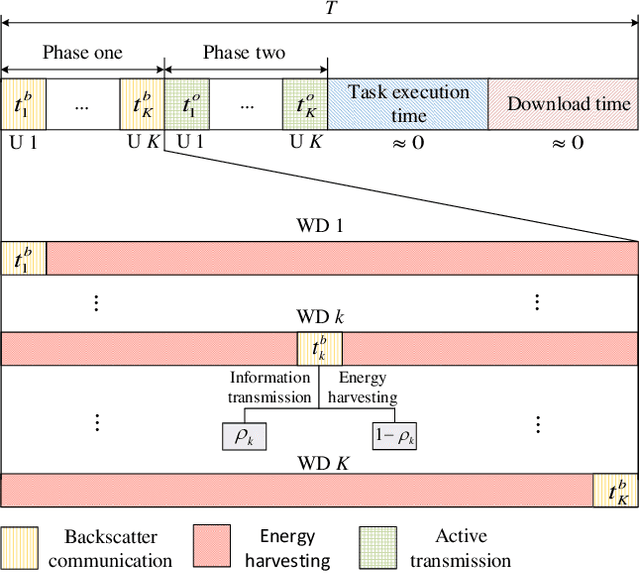
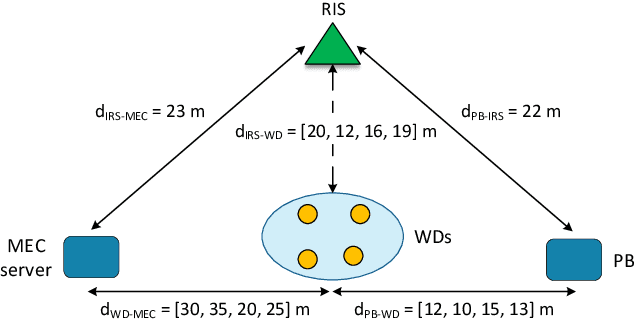
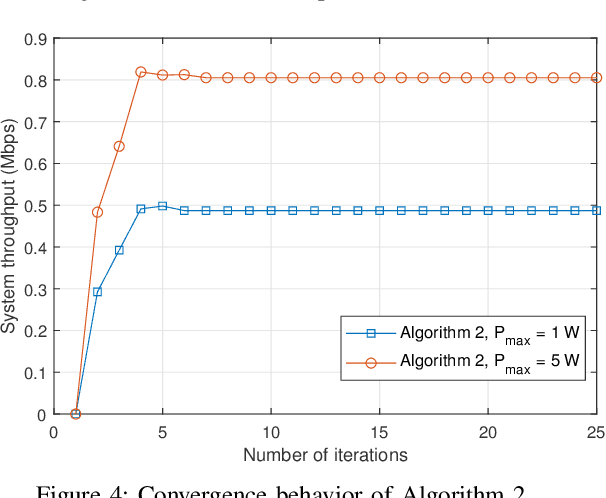
Abstract:We investigate a wireless power transfer (WPT)-based backscatter-mobile edge computing (MEC) network with a {reconfigurable intelligent surface (RIS)}.In this network, wireless devices (WDs) offload task bits and harvest energy, and they can switch between backscatter communication (BC) and active transmission (AT) modes. We exploit the RIS to maximize energy efficiency (EE). To this end, we optimize the time/power allocations, local computing frequencies, execution times, backscattering coefficients, and RIS phase shifts.} This goal results in a multi-objective optimization problem (MOOP) with conflicting objectives. Thus, we simultaneously maximize system throughput and minimize energy consumption via the Tchebycheff method, transforming into two single-objective optimization problems (SOOPs). For throughput maximization, we exploit alternating optimization (AO) to yield two sub-problems. For the first one, we derive closed-form resource allocations. For the second one, we design the RIS phase shifts via semi-definite relaxation, a difference of convex functions programming, majorization minimization techniques, and a penalty function for enforcing a rank-one solution. For energy minimization, we derive closed-form resource allocations. We demonstrate the gains over several benchmarks. For instance, with a $20$-element RIS, EE can be as high as 3 (Mbits/Joule), a 150\% improvement over the no-RIS case (achieving only 2 (Mbits/Joule)).
 Add to Chrome
Add to Chrome Add to Firefox
Add to Firefox Add to Edge
Add to Edge